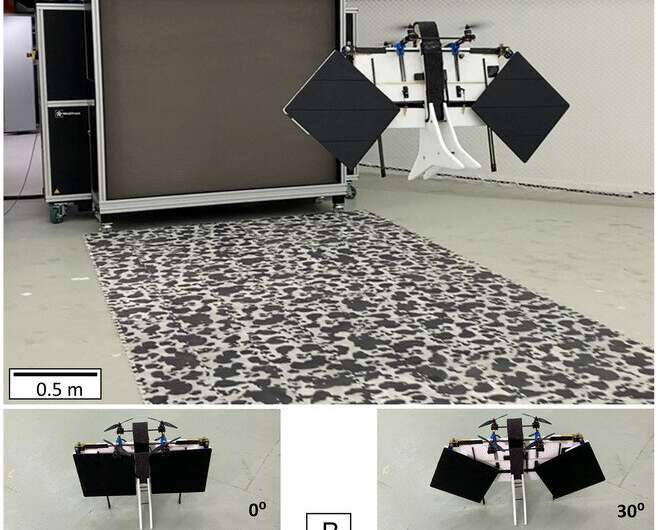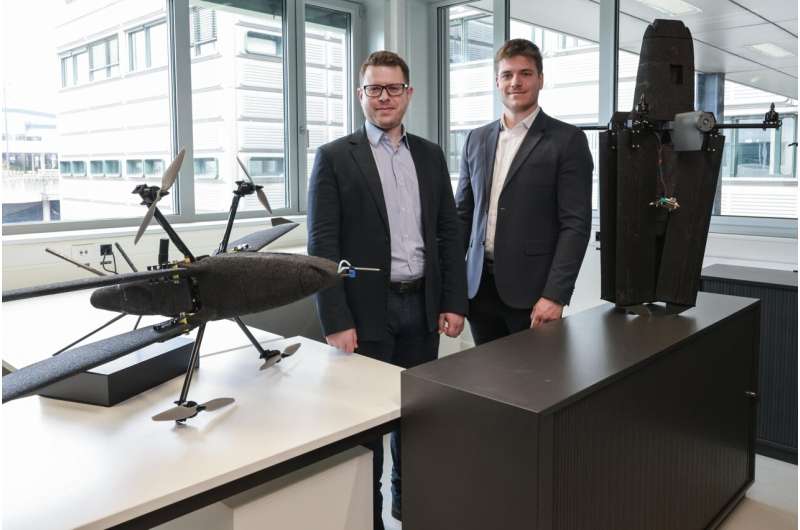This article has been reviewed according to Science X's editorial process and policies. Editors have highlighted the following attributes while ensuring the content's credibility:
fact-checked
trusted source
proofread
New inspection drone uses wind to lengthen flight times

Elythor, an EPFL spin-off, has developed a new drone whose wing shape can adapt to wind conditions and flight position in real time, reducing the drone's energy consumption. What's more, the position of the wings can change, allowing the drone to fly vertically or horizontally. These features make it a perfect candidate for inspecting power plants.
For centuries humans have been fascinated by how easily birds glide through the air. Their instinctive ability to use wind to their advantage is what inspired Morpho, the new inspection drone developed by Elythor. Part winged drone, part quadcopter, Morpho is a hybrid unmanned aerial vehicle (UAV) that can change shape according to the task at hand.
Morpho's adaptive wings extend the drone's flight time and give it greater maneuverability. Combined with embedded sensors and cameras, these features let it fly just as well in enclosed spaces as in the open air, making it ideal for inspecting power plants and other infrastructure like high-voltage power lines, wind turbines, gas pipelines and offshore oil platforms.
Cutting costs by a third and reducing inspection time
When sitting on its four legs, Morpho has a streamlined shape that resembles a tiny rocket. But that quickly changes once its rotors start whirring. The drone's vertical take-off capability means it can be deployed in confined spaces, fly to within just a few centimeters of a piece of equipment, and inspect the equipment without bumping into it.
Once the inspection is completed, Morpho can shift its motors and rotate into a horizontal, more aerodynamic position and swiftly fly off to the next inspection site. If the drone encounters strong or rapidly changing winds along the way, it will expand or contract its wings as necessary to maintain its trajectory. It can also glide under the right wind conditions. All that saves time during inspections, but also means the drone can fly for longer.
"We calculated that using Morpho can cut the time and cost of a drone inspection by an average of 35%," says Harry Vourtsis, Elythor co-founder and CEO. Once Morpho reaches the next inspection site, it can fold up its wings and return to a vertical position in order to fly right up to the equipment. Vourtsis and colleagues have published an article in Advanced Intelligent Systems on their drone.
Asymmetric wing adjustment provides stability in strong winds
"Winged drones have the advantage of longer flight times, while quadcopters have better maneuverability," says Vourtsis. "We combined the two and added an adaptative wing system that reduces the drone's power requirement even further." Most fixed-wing vertical take-off and landing (VTOL) drones represent a compromise, with wings that are small enough to reduce friction during vertical flight yet large enough to provide sufficient lift during horizontal flight. VTOL drones also have trouble taking off and landing in strong winds due to their large surface area perpendicular to the wind.
Morpho's wing control system is the result of several years of research at EPFL's Laboratory of Intelligent Systems and has been described in a number of scientific articles. The system includes sensors linked to a software program for monitoring wind direction and speed.
Nathan Müller, also an Elythor co-founder, explains, "The controller automatically selects whether to hold the wings in place or let them move freely with the wind, based on the drone's trajectory and effective speed, along with any changes in wind direction. The wings' surface area can also be adjusted either symmetrically or asymmetrically depending on wind direction."
The algorithms powering the control system seek not just to optimize the trade-off between air friction and lift, but also to minimize power use. This entails taking advantage of wind currents to let the drone glide or adjusting the wings asymmetrically to regulate its yaw—or the rotation around its vertical axis. This provides greater stability in heavy winds.
Quantitative studies carried out at the EPFL lab show that Morpho delivers considerably better maneuverability and power efficiency. "Our design can reduce power use by up to 85% when the drone is flying in the vertical position," says Müller. "It also significantly improves the drone's attitude and stability." These benefits mean Morpho can perform inspections under a broader range of weather conditions.

'We want to revolutionize inspection platforms'
Because Elythor aims to provide customers with a turnkey solution, it's also developing software for compiling and analyzing the data collected by Morpho. "We want to revolutionize inspection platforms," says Vourtsis. Today, power plant operators use different kinds of drones depending on where the equipment to inspect is located. And the facilities sometimes stretch over several kilometers and include complicated structures that must be entered, like wind turbines and transmission towers.
Elythor has plans to get its drone ready for industrial production in the coming months, with a market launch slated for the end of this year.
More information: Charalampos Vourtsis et al, Wind Defiant Morphing Drones, Advanced Intelligent Systems (2023). DOI: 10.1002/aisy.202200297
Charalampos Vourtsis, Resilient drones with morphing wings, Lausanne, EPFL (2023). DOI: 10.5075/epfl-thesis-9682
Charalampos Vourtsis et al, Robotic Elytra: Insect-Inspired Protective Wings for Resilient and Multi-Modal Drones, IEEE Robotics and Automation Letters (2021). DOI: 10.1109/LRA.2021.3123378
Charalampos Vourtsis et al, Insect Inspired Self-Righting for Fixed-Wing Drones, IEEE Robotics and Automation Letters (2021). DOI: 10.1109/LRA.2021.3096159


















